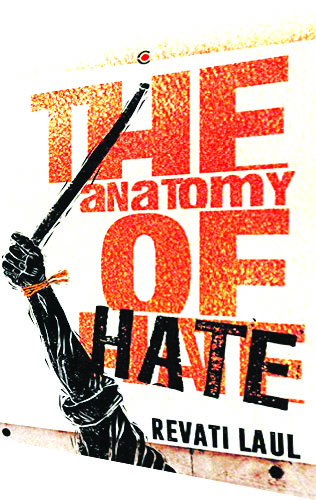The Anatomy of Hate
Revati Laul
Westland Books
Rs.1,499 Pages 220
The author has chosen to study three individuals who swiftly meld into mobs, to understand the circumstances and motivations that make them ready tools of politicians and revivalists

In recent years, there has been an increasing tendency of enraged vigilante groups running amok, creating havoc and mayhem in civic society. Under the protection and cover of powerful politicians, safety of numbers, and official complicity, horrific crimes have been perpetrated countrywide by lynch mobs.
Independent journalist, film maker, and social reformer, Revati Laul has bravely investigated the identities of individuals who quickly band into riotous mobs indulging in loot, arson and worse.
Using the Gujarat riots of 2002 as the backdrop canvas, Laul has chosen to study the personalities of some individuals who swiftly meld into mobs, to understand the “belly of the beast” and the circumstances and motivations that make them ready tools of politicians, revivalists and criminal elements.
Laul has selected three individuals — Pranav, Dungar and Suresh —from differing social and cultural backgrounds to investigate this phenomenon. Over 14 years of interviews and research, battling threats and trolling, and support through financial crises by angel investors, she has compiled this path-breaking anatomy of pliable foot soldiers of hate mongers. She expresses special gratitude to 105 unknown people who crowd-funded this study contributing Rs.9.6 lakh within 15 days, because they believed this book needed to be written — and read.
Pranav — a pseudonym — is a college-going Brahmin youth, with no specific ideology, who is swept into the riots, witnesses the mayhem and together with some college mates, seizes opportunities to loot up-market department stores.
After graduating and job hunting, he finds himself working in an NGO engaged in rehabilitation of the victims of communal riots, and comes face-to-face with those whom his orthodox Hindu culture had taught to hate. It took Laul ten years of interaction to get Pranav to detail the mental trauma he suffered because of contradictions between his Hindu upbringing and his remorse for atrocities inflicted on Muslim neighbours during the 2002 riots in Gujarat.
Dungar — also a pseudonym — is a Bhil tribal, member of a community isolated by the accident of birth, who can’t see a way out of poverty, struggle and menial existence. In the RSS, he discerns a passport to upward mobility. By participating in their satsanghs he rises rapidly up the ranks of the sangh parivar (RSS family) because of his extraordinary ability to arouse and inflame mobs, charging them up with unlimited quantities of illegally brewed country liquor made available by the parivar in the “dry” state of BJP ruled Gujarat. Under the protection of the parivar, his rise is meteoric and he is currently a political leader.
Suresh ‘Langdo’ is from the Chahar community which has a historical tradition of thievery, violence and lawlessness. Stricken by polio at a young age, he compensated his handicap by persistent body building to transform into the neighbourhood bully. He marries, loves, tortures and brutalises Farzana, a Muslim woman, whom he disguises as a Hindu.
Incited by a woman MLA, he joins mobs that slaughtered, raped, looted Muslims in Naroda-Patiya, Ahmedabad, for three days and nights during the 2002 anti-Muslim riots in Gujarat. Snared in a sting operation by Ashish Khetan of Tehelka, who goaded him into boasting about his barbarism, he is sentenced to 31 years of imprisonment. However, many of his more discreet accomplices escaped the arm of the law through protection of the then government machinery.
The dominant theme of this landmark book is the careful selection by sangh parivar activists of disenfranchised youths, their nurturance and indoctrination to arouse mobs against Muslim communities. Laul maintains a sharp focus on these actors to provide insights into their minds and the compulsions that drive them. She deliberately avoids detailing the horrific incidents of the pogrom, as according to her, enough and more has been written — and buried — about it.
Perhaps the only lacuna in this painstakingly researched book is that it doesn’t describe the step-by-step indoctrination of innocent youth by well-trained RSS pracharaks into enraged anti-Muslim fanatics ready to commit inhuman atrocities against them, many of them neighbours they have grown up with. Reports from other sources indicate that the modus operandi is to narrate a distorted history of alleged Muslim atrocities against Hindus stretching back centuries, and to illustrate that nothing has changed. They concoct fake eyewitness accounts of the congenital anti-Hindu animosity of Muslims. Even educated Hindu youth are often susceptible to such manufactured narratives.
The Anatomy of Hate is a must read for citizens committed to constitutional values. It analyses the continuous strategy of sangh parivar outfits to recruit foot soldiers, shows how they transform individuals into hate-filled mobs, which become the tools in implementing the Hindu majoritarian agenda of the RSS and sangh parivar.
Anil Thakore
























